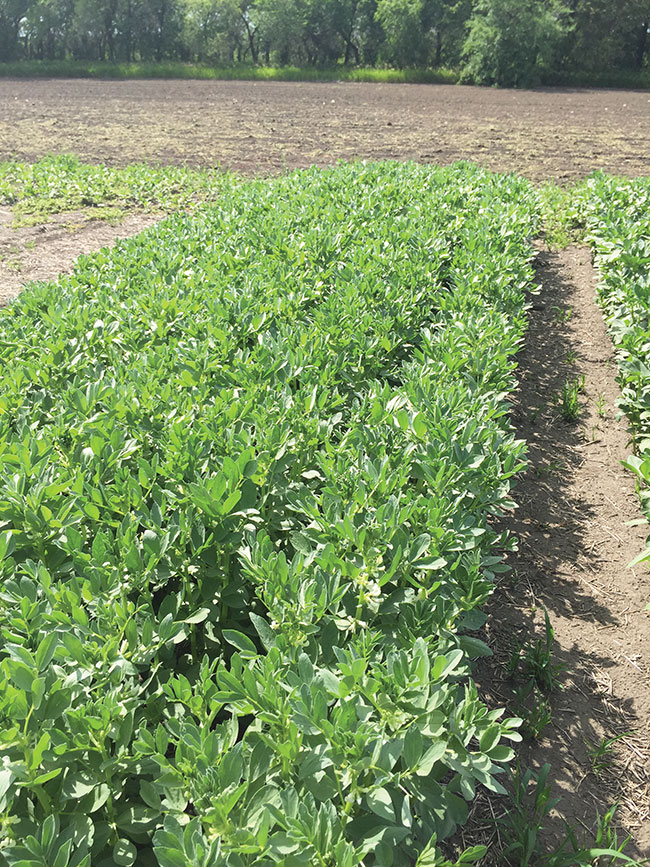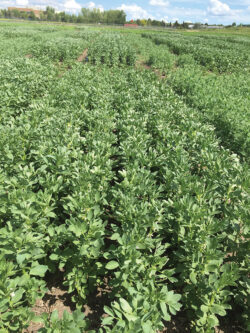
Features
Pulses
Seeding/Planting
Investigating faba bean seeding rates
Research found five viable seeds per square foot maximized profitability.
April 23, 2023 By Bruce Barker
 Research identified the best seeding rates for different seed sizes in faba bean.
Photo courtesy of Jessica Slowski.
Research identified the best seeding rates for different seed sizes in faba bean.
Photo courtesy of Jessica Slowski. Faba bean seed ranges in size from 325 to 750 grams per thousand kernels. Since the majority of seeding rate recommendations were developed for small-seeded varieties, Saskatchewan research looked at whether seeding rate should vary by different seed sizes.
“Overall, research using current varieties, management practices, and environmental conditions is warranted to ensure that stable, high-yielding, and high-quality faba bean crops can be produced in Saskatchewan,” says Jessica Slowski, who completed the research as part of her master of science degree at the University of Saskatchewan in 2019. “This research project was initiated to investigate the optimal seeding rate and disease management practices on faba bean varieties cultivated in Saskatchewan.”
The objective of the seeding rate experiment was to identify the optimal seeding rate required to maximize yield and profitability in three faba bean varieties of various seed sizes. Slowski says that the optimal seeding rate is highly dependent on seed costs, especially with large seeded faba beans, and because of diminishing returns of higher seeding rates.
Previous research in Alberta by Sheri Strydhorst found that the optimum target plant population in north central Alberta was 4.3 plants per square foot (43 plants/m2), but it differed depending on growing conditions. With good growing conditions, 3.2 plants/ft2 achieved optimal yields, but under drought conditions, higher plant populations were required for higher yields. And under weedy conditions, seeding rates of seven to nine plants/ft2 were required for high, stable yields.
Slowski conducted research in Melfort and Saskatoon, Sask., over three years from 2015 through 2017 to help develop made-in-Saskatchewan recommendations. Melfort is located in the Black soil zone, and Saskatoon in the Dark Brown soil zone.
Three faba bean varieties were grown to represent different classes and seed sizes. CDC SSNS-1 is a small-seeded tannin variety with 335 Thousand Kernel Weight (TKW). CDC Snowdrop is another small-seeded low-tannin variety with 325 TKW. Representing a large-seeded tannin variety with 680 TKW was FB9-4.

Research identified the best seeding rates for different seed sizes in faba bean.
In 2015 and 2016, seeding rate ranged from two, four, six, eight and 10 viable seeds/ft2 (20, 40, 60, 80, and 100 viable seeds/m2 ). In 2017, the seeding rates were modified to 0.5, one, two, four and six viable seeds/ft2 (five, 10, 20, 40, and 60 viable seeds/m2) to provide a more refined yield response curve. Actual seeding rates were determined based on percent germination and TKW
Slowski says the study was conducted using viable seeds/ft2 instead of targeted plants/ft2 stand establishment because viable seeds/ft2 can be directly controlled by a grower, while plants/ft2 is subjected to many external factors such as seedling mortality, poor emergence, and root rots.
“At the time, part of the discussion was the use of planters to seed faba beans, which is based on viable seeds per acre. We thought that using a seeding rate based on viable seeds was a good way to look at rates that optimized yields,” says Slowski.
As expected, established plant populations increased linearly with increasing seeding rate. There were few agronomic differences in stand establishment between varieties.

Optimum economic seeding rate of 4.5 viable seeds/ft2
Yield differed by site and year. Melfort 2015 and 2017, and Saskatoon 2017 had a quadratic response where yield initially increased with increasing seeding rates, then leveling off and declining. The other site years had a linear response.
Slowski explains the seeding rate required to reach maximum agronomic yield ranged from two to 7.7 seeds/ft2, with an average of 4.9 seeds/ft2. She says under good growing conditions with more rainfall (Melfort in 2016 and Saskatoon in 2015 and 2016), maximum agronomic yields were reached at two seeds/ft2 and either remained the same or declined with higher seeding rates. In drier conditions at the other site years, a seeding rate of between three and 7.7 viable seeds/ft2, with an average of 5.4 seeds/ft2, provided maximum agronomic yield.
Based on the research, Slowski says seeding 4.9 to 5.4 viable seeds/ft2 would provide maximum agronomic yield under a wide range of Saskatchewan growing conditions. Generally, these seeding rates resulted in a stand establishment of around four to five plants/ft2, which is similar to the target plant population of 4.5 plants/ft2 recommended by Saskatchewan Pulse Growers and the Saskatchewan Ministry of Agriculture.
An optimal economic seeding rate was also calculated, based on an average seed cost of $0.23 per pound ($0.51/kg), a faba bean commodity price of $0.10 per pound ($0.22/kg), and an opportunity cost of 10 per cent. This resulted in an economic seeding rate of 4.5 viable seeds/ft2, but varied by variety. CDC Snowdrop had an economically optimal seeding rate of 4.9 viable seeds/ft2, CDC SSNS-1 at 4.7 viable seeds, and FB9-4 at 3.5 viable seeds.
A disease management study was also conducted as part of the research. It looked at the impact of seed treatments and foliar fungicide timing on disease development on Snowdrop and CDC SSNS-1 varieties. However, disease pressure was low with minimal response to fungicide applications.